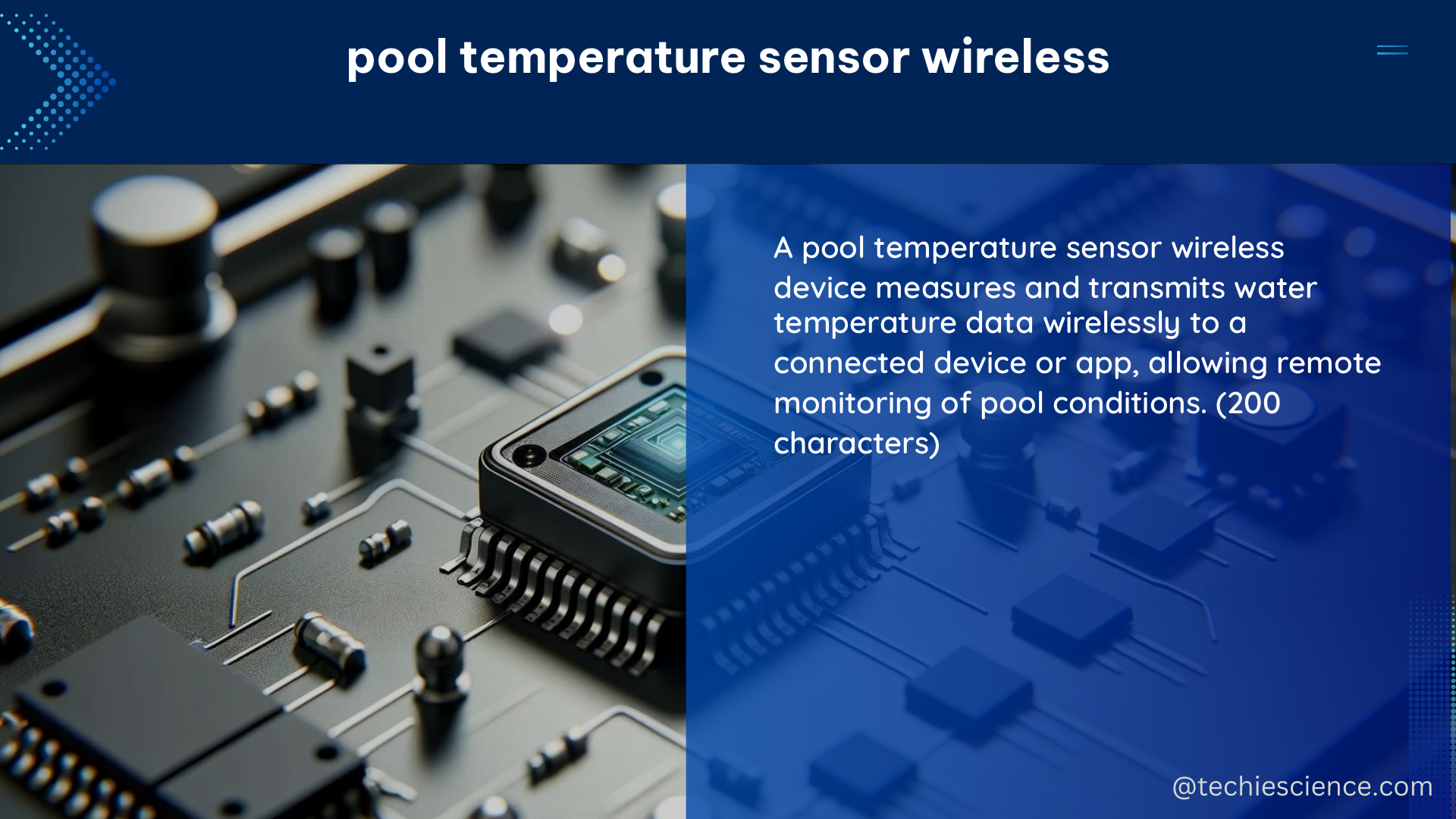The pool temperature sensor wireless is a crucial device for maintaining the ideal temperature in swimming pools, ensuring comfort and safety for swimmers. These sensors typically use wireless communication protocols, such as WirelessHART, to transmit temperature data to a central system for monitoring and control.
Understanding the Technical Specifications
Wireless Communication Protocols
Pool temperature sensor wireless devices commonly utilize the following wireless communication protocols:
-
WirelessHART: This protocol is based on the HART (Highway Addressable Remote Transducer) communication standard and provides reliable, secure, and low-power wireless communication. WirelessHART sensors can transmit data with a typical latency of around 643 ms, with an average of one hop in a mesh network.
-
Zigbee: Zigbee is a low-power, low-data-rate wireless mesh networking standard, often used in home automation and IoT applications. Zigbee-based pool temperature sensors offer a range of up to 100 meters and can form self-healing mesh networks.
-
Bluetooth Low Energy (BLE): BLE is a wireless personal area network technology that provides low-power, short-range communication. BLE-enabled pool temperature sensors can connect directly to smartphones or tablets for easy monitoring and control.
Sensor Accuracy and Precision
The accuracy and precision of pool temperature sensors are crucial for maintaining optimal swimming conditions. High-quality sensors typically have the following specifications:
- Temperature measurement range: 0°C to 50°C (32°F to 122°F)
- Accuracy: ±0.2°C (±0.36°F)
- Resolution: 0.1°C (0.18°F)
- Response time: less than 10 seconds
These specifications ensure that the pool temperature is measured and reported with a high degree of accuracy, allowing for precise temperature control and monitoring.
Power Consumption and Battery Life
Pool temperature sensor wireless devices are designed to operate with low power consumption to maximize battery life. Typical power consumption and battery life specifications include:
- Power consumption: less than 10 mW
- Battery life: up to 5 years on a single battery (depending on usage and environmental conditions)
The use of low-power wireless protocols, such as WirelessHART and Zigbee, along with energy-efficient sensor components, helps to extend the battery life of these devices, reducing the need for frequent battery replacements.
Integration and System Architecture

Pool temperature sensor wireless systems can be integrated into various monitoring and control systems, offering flexibility and scalability.
Centralized Ground Station Data Processing
In a centralized ground station data processing architecture, the pool temperature sensors wirelessly transmit their data to a central control station or server. This station then processes the data, analyzes the pool conditions, and provides control signals to maintain the desired temperature. This approach allows for comprehensive monitoring and control of the entire pool system from a single location.
Distributed Sensor Onboard Processing
Alternatively, pool temperature sensor wireless systems can utilize a distributed sensor onboard processing approach. In this setup, each sensor is equipped with its own microprocessor and control algorithms, allowing it to make autonomous decisions and adjustments based on the local temperature data. This decentralized architecture can offer faster response times and increased reliability, as the system can continue to function even if the central control station experiences issues.
Integration with Building Management Systems
Pool temperature sensor wireless systems can be seamlessly integrated into building management systems (BMS) or smart home automation platforms. This integration allows for centralized monitoring and control of the pool temperature, along with other building systems, such as HVAC, lighting, and security. The pool temperature data can be accessed and managed through the BMS interface, providing a comprehensive view of the entire facility.
Maintenance and Troubleshooting
Proper maintenance and troubleshooting are essential for ensuring the long-term reliability and performance of pool temperature sensor wireless systems.
Sensor Calibration and Validation
Periodic calibration and validation of the pool temperature sensors are crucial to maintain accuracy and precision. This process involves comparing the sensor readings with a known, calibrated reference source and making any necessary adjustments to the sensor’s calibration parameters.
Wireless Network Optimization
Ensuring the optimal performance of the wireless network is essential for reliable data transmission. This includes:
- Monitoring signal strength and network connectivity
- Identifying and mitigating any interference or obstructions
- Adjusting the network topology (e.g., mesh vs. star) for optimal coverage and reliability
Battery Replacement and Power Management
Regular monitoring of the sensor’s battery life and timely replacement of batteries are necessary to prevent unexpected system downtime. Additionally, implementing power management strategies, such as sleep modes and low-power operation, can help extend the battery life of the sensors.
Conclusion
Pool temperature sensor wireless systems are essential for maintaining optimal swimming pool conditions, ensuring the comfort and safety of swimmers. These systems offer precise temperature measurement, low-latency data transmission, and flexible integration into various monitoring and control systems. By understanding the technical specifications, integration options, and maintenance requirements, pool operators can effectively leverage these wireless sensors to optimize their pool temperature management and enhance the overall swimming experience.
References:
- SmartMesh WirelessHART Application Notes
- AI4SES Report 2023
- 2023 Model Aquatic Health Code (MAHC) Annex
- Zigbee Alliance: Pool and Spa Control
- Bluetooth SIG: Bluetooth for Pool and Spa Applications

The lambdageeks.com Core SME Team is a group of experienced subject matter experts from diverse scientific and technical fields including Physics, Chemistry, Technology,Electronics & Electrical Engineering, Automotive, Mechanical Engineering. Our team collaborates to create high-quality, well-researched articles on a wide range of science and technology topics for the lambdageeks.com website.
All Our Senior SME are having more than 7 Years of experience in the respective fields . They are either Working Industry Professionals or assocaited With different Universities. Refer Our Authors Page to get to know About our Core SMEs.